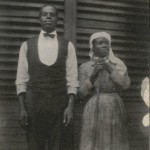February is “Black History Month”. We wanted to mention that there were, in fact, some African Americans who were members of the Koreshan Unity even though very little is known of them.
Throughout the years it has been said that laborers who built the canals on the Unity grounds were mostly black. That may or may not be true. It appears that Cyrus Teed believed in the equality of the races as well as of the sexes. Of course, that may have meant, in the late 19th century and early 20th century — “separate but equal”. There is little or no evidence of just who or how many blacks were members of the Unity. Our only clues are a few remaining items from our own archives and from the State Archives.
1)The Koreshan Unity Membership List:
Long after Teed’s death, in 1963, Claude Rahn a long time member of the Unity compiled a Membership List. This list seemed to be an attempt to list as many members, former members etc. of the Koreshan Unity. Rahn listed the name and (if available) the date they entered the Unity. In the case of African Americans, he only listed their name and then, in parenthesis, the word “colored”. Here are those entries from the list
Derry, Joseph and Sarah
Jackson, Carl and Emma
Patsy (no last name given)
2)Other sources:
FLAMING SWORD, Community Current Events by Max E. Arendt, September 1932:
“Word reaches us of the sudden death of Carl Jackson, recently of Paisley,
Florida, and at one time connected with the Koreshan movement in Chicago in
the early days. Mr. Jackson was active in organization work among colored
people up to the time of his death.”The 1930 U.S. Census lists Mr. Jackson and his family:
Carl Jackson, Age-53, born in Illinois
Terlissia Jackson, Wife, age-30, born in FloridaThen his children, all born in Florida:
Catherine Jackson, Daughter, age-15
Sylvester Jackson, Son, age-5
Arie Jackson, Daughter, age-4
Isadora Jackson, Daughter, age-2
Pauline Jackson, Daughter, age-<1
3)Photos:
In the collection there is one picture of an African American child with a possum on a leash, but no mention of who the person was. When the photographs that were stored in the Koreshan Unity archives were being transferred to the State Archives, many of them were scanned for reference purposes. This small amount of evidence shows us a photo of an African American man and woman, simply identified as “Annie and Watson” and that there were two children known as the Johnson Twins, based on the identification on the back. Take a look at these photos:
The back of the last photo (also a postcard) says: “This is inside of the yard of the office, [?] is one of the twins of Jack Johnson, it was the largest possum I ever saw. JHB”. “JHB” was James H. Bubbett.
With all that in mind we offer this small tribute to at least “some” of the African Americans who either belonged to or were employed by the Koreshan Unity.


